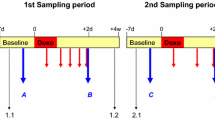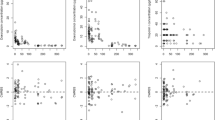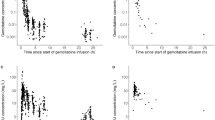Abstract
Background and Objective
Knowledge on the pharmacokinetics of doxorubicin, especially in children, is very limited with conflicting evidence concerning a possible age dependency in the pharmacokinetics. The aim of the current investigation was to assess, by using population pharmacokinetics, whether an age dependency in the clearance (CL) of doxorubicin exists.
Methods
Pharmacokinetic data of doxorubicin and its main metabolite doxorubicinol from 94 children (aged 0–18 years) from the EPOC-MS-001-Doxo trial were available. A population pharmacokinetic model was developed in NONMEM® 7.2.0.
Results
A linear three-compartment model for doxorubicin, with one additional compartment for doxorubicinol, gave the best fit to the data. All model parameters were linearly scaled on body surface area. Including a power function of age as a covariate for CL led to a further improvement of the model. Variation in genes encoding for enzymes involved in the metabolism or active transport of doxorubicin had no influence on the pharmacokinetics. Estimates of CL were lower (26.6 L/h/m2 in children aged >3 years and 21.1 L/h/m2 in children aged ≤3 years, p = 0.0004) in children aged <3 years, compared with older children.
Conclusions
This is the first model to describe the pharmacokinetics of doxorubicin in children, with a specific focus on infants and children aged <3 years. The lower CL in younger children should be considered together with the pharmacodynamics, especially the cardiotoxicity, when selecting the dose for future protocols.





Similar content being viewed by others
References
van Dalen EC, Raphael MF, Caron HN, Kremer LC. Treatment including anthracyclines versus treatment not including anthracyclines for childhood cancer. Cochrane Database Syst Rev. 2014;9:CD006647.
Eksborg S, Strandler HS, Edsmyr F, Naslund I, Tahvanainen P. Pharmacokinetic study of i.v. infusions of adriamycin. Eur J Clin Pharmacol. 1985;28(2):205–12.
Blum RH, Carter SK. Adriamycin. A new anticancer drug with significant clinical activity. Ann Intern Med. 1974;80(2):249–59.
Olson RD, Mushlin PS, Brenner DE, Fleischer S, Cusack BJ, Chang BK, et al. Doxorubicin cardiotoxicity may be caused by its metabolite, doxorubicinol. Proc Natl Acad Sci USA. 1988;85(10):3585–9.
Robert J, Bui NB, Vrignaud P. Pharmacokinetics of doxorubicin in sarcoma patients. Eur J Clin Pharmacol. 1987;31(6):695–9.
Rodvold KA, Rushing DA, Tewksbury DA. Doxorubicin clearance in the obese. J Clin Oncol. 1988;6(8):1321–7.
Piscitelli SC, Rodvold KA, Rushing DA, Tewksbury DA. Pharmacokinetics and pharmacodynamics of doxorubicin in patients with small cell lung cancer. Clin Pharmacol Ther. 1993;53(5):555–61.
Ryu RJ, Eyal S, Kaplan HG, Akbarzadeh A, Hays K, Puhl K, et al. Pharmacokinetics of doxorubicin in pregnant women. Cancer Chemother Pharmacol. 2014;73(4):789–97.
McLeod HL, Relling MV, Crom WR, Silverstein K, Groom S, Rodman JH, et al. Disposition of antineoplastic agents in the very young child. Br J Cancer Suppl. 1992;18:S23–9.
Palle J, Frost BM, Peterson C, Gustafsson G, Hellebostad M, Kanerva J, et al. Doxorubicin pharmacokinetics is correlated to the effect of induction therapy in children with acute myeloid leukemia. Anticancer Drugs. 2006;17(4):385–92.
Frost BM, Eksborg S, Bjork O, Abrahamsson J, Behrendtz M, Castor A, et al. Pharmacokinetics of doxorubicin in children with acute lymphoblastic leukemia: multi-institutional collaborative study. Med Pediatr Oncol. 2002;38(5):329–37.
Hempel G, Flege S, Wurthwein G, Boos J. Peak plasma concentrations of doxorubicin in children with acute lymphoblastic leukemia or non-Hodgkin lymphoma. Cancer Chemother Pharmacol. 2002;49(2):133–41.
Thompson PA, Rosner GL, Matthay KK, Moore TB, Bomgaars LR, Ellis KJ, et al. Impact of body composition on pharmacokinetics of doxorubicin in children: a Glaser Pediatric Research Network study. Cancer Chemother Pharmacol. 2009;64(2):243–51.
Barry E, Alvarez JA, Scully RE, Miller TL, Lipshultz SE. Anthracycline-induced cardiotoxicity: course, pathophysiology, prevention and management. Expert Opin Pharmacother. 2007;8(8):1039–58.
Hempel G, Schulze-Westhoff P, Flege S, Laubrock N, Boos J. Therapeutic drug monitoring of doxorubicin in paediatric oncology using capillary electrophoresis. Electrophoresis. 1998;19(16–17):2939–43.
Maudens KE, Stove CP, Cocquyt VF, Denys H, Lambert WE. Development and validation of a liquid chromatographic method for the simultaneous determination of four anthracyclines and their respective 13-S-dihydro metabolites in plasma and saliva. J Chromatogr B Analyt Technol Biomed Life Sci. 2009;877(30):3907–15.
Kontny NE, Hempel G, Boos J, Boddy AV, Krischke M. Minimization of the preanalytical error in plasma samples for pharmacokinetic analyses and therapeutic drug monitoring: using doxorubicin as an example. Ther Drug Monit. 2011;33(6):766–71.
Beal SSL, Boekmann A, Bauer RJ. NONMEM’s user’s guides. Ellicott City: ICON Development Solutions; 2009.
R_Core_Team. R: a language and environment for statistical computing. Vienna: R Foundation for Statistical Computing; 2014.
Keizer RJ, van Benten M, Beijnen JH, Schellens JH, Huitema AD. Pirana and PCluster: a modeling environment and cluster infrastructure for NONMEM. Comput Methods Programs Biomed. 2011;101(1):72–9.
Lindbom L, Pihlgren P, Jonsson EN. PsN-Toolkit: a collection of computer intensive statistical methods for non-linear mixed effect modeling using NONMEM. Comput Methods Programs Biomed. 2005;79(3):241–57.
Jonsson EN, Karlsson MO. Xpose: an S-PLUS based population pharmacokinetic/pharmacodynamic model building aid for NONMEM. Comput Methods Programs Biomed. 1999;58(1):51–64.
IBM Corp. Released 2012. IBM SPSS Statistics for Windows, Version 21.0. Armonk: IBM Corp.
Hempel G, Kontny NE. Pharmacokinetic analysis report for EPOC-MS-001-Doxo: interim analysis, Version V 1.3. 2012. p 13–58.
Callies S, de Alwis DP, Wright JG, Sandler A, Burgess M, Aarons L. A population pharmacokinetic model for doxorubicin and doxorubicinol in the presence of a novel MDR modulator, zosuquidar trihydrochloride (LY335979). Cancer Chemother Pharmacol. 2003;51(2):107–18.
Wilde S, Jetter A, Rietbrock S, Kasel D, Engert A, Josting A, et al. Population pharmacokinetics of the BEACOPP polychemotherapy regimen in Hodgkin’s lymphoma and its effect on myelotoxicity. Clin Pharmacokinet. 2007;46(4):319–33.
Kontny NE, Wurthwein G, Joachim B, Boddy AV, Krischke M, Fuhr U, et al. Population pharmacokinetics of doxorubicin: establishment of a NONMEM model for adults and children older than 3 years. Cancer Chemother Pharmacol. 2013;71(3):749–63.
Blanco JG, Sun CL, Landier W, Chen L, Esparza-Duran D, Leisenring W, et al. Anthracycline-related cardiomyopathy after childhood cancer: role of polymorphisms in carbonyl reductase genes: a report from the Children’s Oncology Group. J Clin Oncol. 2012;30(13):1415–21.
Lal S, Mahajan A, Chen WN, Chowbay B. Pharmacogenetics of target genes across doxorubicin disposition pathway: a review. Curr Drug Metab. 2010;11(1):115–28 (BSP/CDM/E-Pub/00049 [pii]).
Fagerholm R, Hofstetter B, Tommiska J, Aaltonen K, Vrtel R, Syrjakoski K, et al. NAD(P)H:quinone oxidoreductase 1 NQO1*2 genotype (P187S) is a strong prognostic and predictive factor in breast cancer. Nat Genet. 2008;40(7):844–53.
Anderson BJ, Holford NH. Tips and traps analyzing pediatric PK data. Paediatr Anaesth. 2011;21(3):222–37.
Joerger M. Covariate pharmacokinetic model building in oncology and its potential clinical relevance. AAPS J. 2012;14(1):119–32.
Wang DD, Zhang S. Standardized visual predictive check versus visual predictive check for model evaluation. J Clin Pharmacol. 2012;52(1):39–54.
Thompson P, Wheeler HE, Delaney SM, Lorier R, Broeckel U, Devidas M, et al. Pharmacokinetics and pharmacogenomics of daunorubicin in children: a report from the Children’s Oncology Group. Cancer Chemother Pharmacol. 2014;74(4):831–8.
Hempel G, Relling MV, de Rossi G, Stary J, De Lorenzo P, Valsecchi MG, et al. Pharmacokinetics of daunorubicin and daunorubicinol in infants with leukemia treated in the interfant 99 protocol. Pediatr Blood Cancer. 2010;54(3):355–60.
Wong AL, Seng KY, Ong EM, Wang LZ, Oscar H, Cordero MT, et al. Body fat composition impacts the hematologic toxicities and pharmacokinetics of doxorubicin in Asian breast cancer patients. Breast Cancer Res Treat. 2014;144(1):143–52.
Lipshultz SE, Adams MJ. Cardiotoxicity after childhood cancer: beginning with the end in mind. J Clin Oncol. 2010;28(8):1276–81.
Acknowledgments
We wish to thank all clinical investigators and clinical trials centres that participated in the EPOC-MS-001-Doxo trial. This trial and all accompanying research were funded by the European Community’s Seventh Framework Programme (FP7/2009-2013) under Grant Agreement No. 222910. Miriam Krischke and Gudrun Würthwein are supported by the German Federal Ministry of Research and Education (BMBF Grant No. 01KN1105). Joachim Boos served personally as a consultant and participated in advisory boards for the medac GmbH. In addition, there are institutional Grants and cooperation with medac GmbH—all related to asparaginase and/or pharmacovigilance. There is no conflict of interest concerning doxorubicin. Swantje Völler, Nina E. Kontny, Alan V. Boddy and Georg Hempel have no conflicts on interest to declare.
Author information
Authors and Affiliations
Corresponding author
Additional information
A. V. Boddy and G. Hempel contributed equally.
Electronic supplementary material
Below is the link to the electronic supplementary material.
Rights and permissions
About this article
Cite this article
Völler, S., Boos, J., Krischke, M. et al. Age-Dependent Pharmacokinetics of Doxorubicin in Children with Cancer. Clin Pharmacokinet 54, 1139–1149 (2015). https://doi.org/10.1007/s40262-015-0272-4
Published:
Issue Date:
DOI: https://doi.org/10.1007/s40262-015-0272-4




